What is Intangible Cultural Heritage?
As Per UNESCO-
Cultural heritage does not end at monuments and collections of objects. It also includes traditions or living expressions inherited from our ancestors and passed on to our descendants, such as oral traditions, performing arts, social practices, rituals, festive events, knowledge and practices concerning nature and the universe or the knowledge and skills to produce traditional crafts.
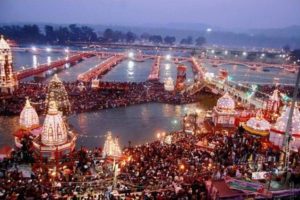
image source indianholiday.com
As Per UNESCO, Intangible cultural heritage is:
- Traditional, contemporary and living at the same time
- Inclusive –contributes to social cohesion, encouraging a sense of identity
- Representative –skills and customs passed on to the rest of the community, from generation to generation
- Community-based
Lets have a glimpse of previous years questions before moving to
the list–
Prelims 2017
With reference to Manipuri Sankirtana, consider the following statements:
- It is a song and dance performance.
- Cymbals are the only musical instruments used in the performance.
- It is performed to narrate the life and deeds of Lord Krishna.
Which of the statements given above is/are correct?
(a) 1, 2 and 3.
(b) 1 and 3 only
(c) 2 and 3 only
(d) 1 only
Prelims 2014
2014 Prelims question-With reference to India’s culture and tradition, what is ‘Kalaripayattu’?
(a) It is an ancient Bhakti cult of Shaivism still prevalent in some parts of South India
(b) It is an ancient style bronze and brasswork still found in southern part of Coromandel area
(c) It is an ancient form of dance drama and a living tradition in the northern part of Malabar
(d) It is an ancient martial art and a living tradition in some parts of South India
UNESCO List of Intangible Cultural Heritages from India :-
1.Kumbh Mela
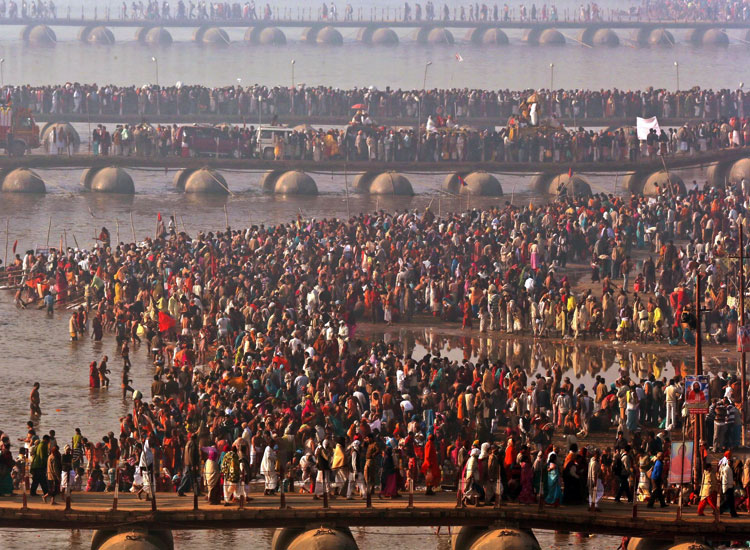
The holy Kumbh Melais reputed as “the world’s most massive act of faith.” Now, the UNESCO has recognized the spiritual festival as an “intangible cultural heritage of humanity” in 2017. Kumbh Mela plays a central spiritual role in the country. The event summarizes the science of astronomy, astrology, spirituality, ritualistic traditions, and social and cultural customs and practices, making it extremely rich in knowledge.
Every 12 years, devotees gather at either of the four locations—Haridwar, Allahabad, Nashik-Trimbakeshwar, and Ujjain Simhastha—to bathe in the holy waters of River Ganga, Triveni Sangam (confluence of Ganga, Yamuna and Saraswati), River Godavari and Kshipra River respectively. The ritual bath is said to free from past sins (karma), thereby becoming eligible for liberation from the cycle of birth and death.
Kumbh Mela (the festival of the sacred Pitcher) is the largest peaceful congregation of ascetics, saints, sadhus, aspirants-kalpavasis and people from all walks of life, without any difference in caste, creed and status, gathered for the divine event.
2.Yoga

The ancient tradition of health and wellness, Yoga is that has gained international recognition. It does not come as a surprise that on 2016, Yoga was inscribed on the UNESCO list of Intangible Cultural Heritage. The ancient Indian practice is based on unifying the mind with the body and soul to allow for greater mental, spiritual and physical wellbeing.
Said to have originated as the knowledge of the ‘Rishis’, holy souls who had attained spiritual powers with years of disciplined life. The awareness was later passed on to the world. Series of poses, meditation, controlled breathing, word chanting and other techniques are a part of Yoga. The practice of Yoga is said to aid in self-realization, ease any suffering and allow for a state of liberation. Traditionally, yoga was transmitted using the Guru-Shishya model (master-pupil) with gurus as the main custodians of the knowledge. The annual Yoga Festival in Rishikesh is a celebration of the ancient wealth of knowledge of health and wellness.
3.Navroz – Parsi New Year
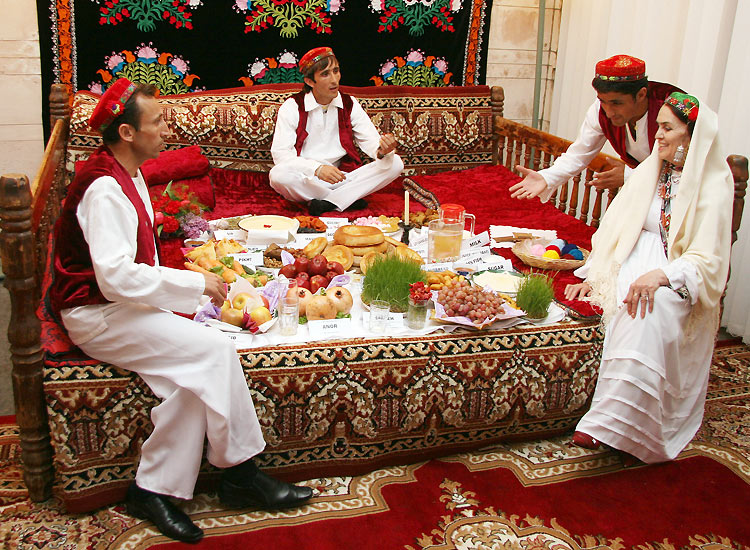
Navroz, the celebrations of the Iranian New Year is a festival that is inscribed by UNESCO as Intangible Cultural Heritage in 2009. The festival is celebrated by Parsis, followers of Zoroastrianism all over the world. Navroz has its own kind of traditions, rituals and festivities spread over a vast geographical area on March 21 in Afghanistan, Azerbaijan, India, Iran, Iraq, Kazakhstan, Kyrgyzstan, Pakistan, Tajikistan, Turkey, Turkmenistan and Uzbekistan.
Navroz is the New Year day, a start for the two week festivities. India celebrates Jamshed Navroz. Exchanging of gifts, feasts with family and friends are common celebrations while some countries also have street performances of music and dance, public rituals involving water and fire, traditional sports and the making of handicrafts and merry-making. The small community of Parsis and their way of life is slowly depleting, therefore needs to be preserved for continuity in the coming years.
4.Traditional brass and copper craft of utensil making by Thatheras of Jandiala Guru, Punjab

Brass and copper utensils were the norm of the Indian kitchen in the olden days. The art of making these utensils were praiseworthy. The ancient practice is almost lost except the group of people- the Thanteras of Jandiala Guru in Punjab. The olden tradition of brass and copper utensils making had made its name on the list of the UNESCO Intangible Cultural Heritage in India.
The craft of the making of the utensils is important, both in utility and ritual. Copper, brass and kansa (an alloy of copper, ton and zinc) are primarily used. These utensils are recommended by Ayurveda, the ancient Indian science of health and wellness for cooking and eating. The use and sales of the said utensils is said to have decreased over the years as their maintenance is very time consuming. As people bring stainless steel or aluminum in their kitchen, the tradition and the art is losing its value.
5.Sankirtana, ritual singing, drumming and dancing of Manipur
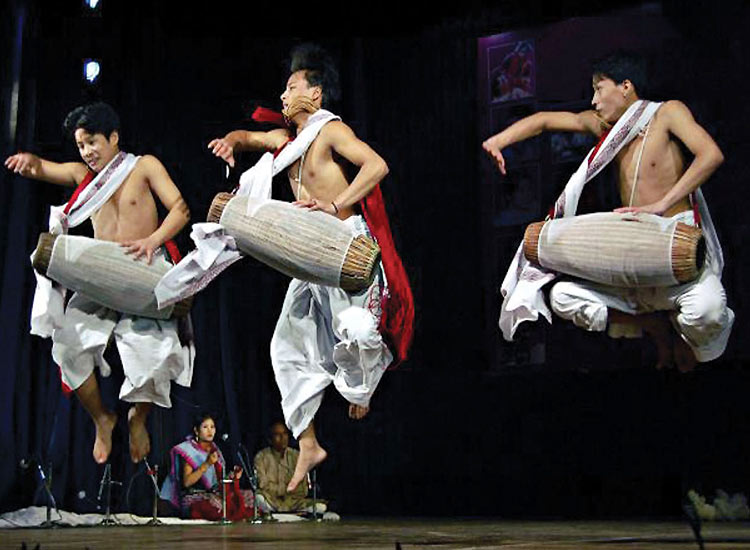
Sankirtana is an art form of ritual singing, drumming and dancing that has spiritual origins in the North East Indian province of Manipur. The unique tradition has been inscribed on the list of UNESCO Intangible Cultural Heritage of India on 2013.
Marking the various stages in the lives of Vaishnava people of Manipur, Sankirtana includes a number of art forms. The tradition was started by the Manipuri Hindus in the 15th century by princesses in palaces. Later, it spread to all corners of the states and is said to be been its pinnacle in the 18th century. People believed in other yugas – Dwapar, Treta, Satya, one could obtain ‘punya’ (merit) in various ways which would lead you to ‘Moksha’ (transcendence) from the circle of birth, but in Kaliyuga, punya and moksha is achievable through Sankirtan. Sankirtan uses 100 different taals or rhythmic variations to praise the name of lord and feel your soul cleansed in the harmonious melodies.
6.Buddhist texts chanting of Ladakh
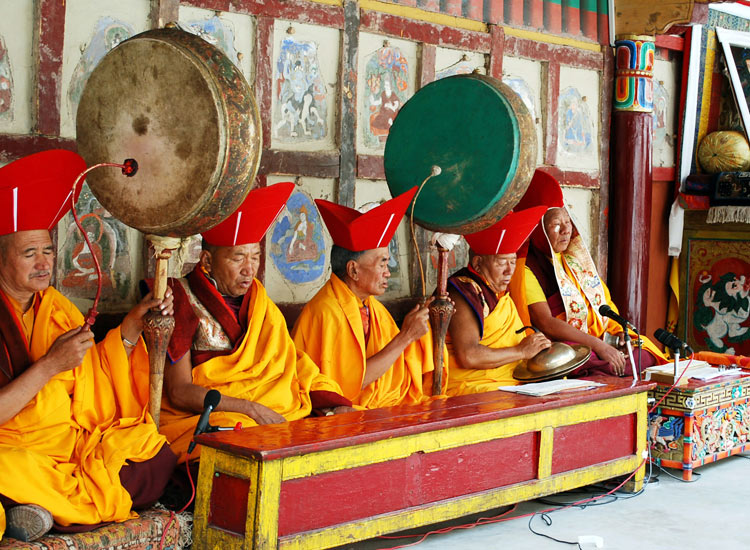
Buddhism is a widespread religion which has ancient roots in India. It is very much a part of the Indian culture and heritage. The chanting of Buddhist texts in monasteries of Ladakh is now inscribed on the list of UNESCO Cultural Heritage of India on 2012.
Chanting of sacred texts is said to have positive affect on both performers and listeners, taking the soul towards spiritual enlightenment. Chanting has always been an auspicious ritual of Buddhism. Ladakh, known as mini Tibet has ancient roots of Buddhism in the high mountains of Himalayas. Two major sects of Buddhism in Ladakh include the Mahayana and the Vajrayana. The Buddhist monks are called lamas. The chanting of the holy texts of Buddhism is performed in groups. The ritual is performed during a monastery festival, or on spiritual bliss in a private residence. There is a special dress for the chanting and the lamas make hand gestures with each chant to represent what Buddha preached.
7.Chhau dance: Semi Classical Dance from Eastern India

Chhau is semi-classical form of tribal dance, combining martial arts, storytelling, martial arts, mock combat, acrobatics, and athletics and story-telling based in eastern India- Orissa, Jharkhand & West Bengal. The unique dance form is inscribed in the list of UNESCO World Heritage Site in 2010. The tribal heritage gains recognition and gets preservation after the UNESCO status.
The origin of the dance is shrouded in mystery, but basically Chhau started as a means to portray stories to the audience. The tales are taken from two great epics of Indian Mythology – Ramayana and Mahabharata, Puranas and other Indian Literature with religious themes found in Shaivism, Shaktism and Vaishnavism. Performers decked in colorful attire, massive masks, and other ornaments dance on the beats of Indian instruments – Dhol, Shehnai and Dhamsa (percussion instrument and Indian clarinets) without vocals. The dance is performed in a joyous occasion or religious festivals especially Gajan festival, dedicated to Lord Shiva.
8.Kalbelia – Folk songs and dances of Rajasthan
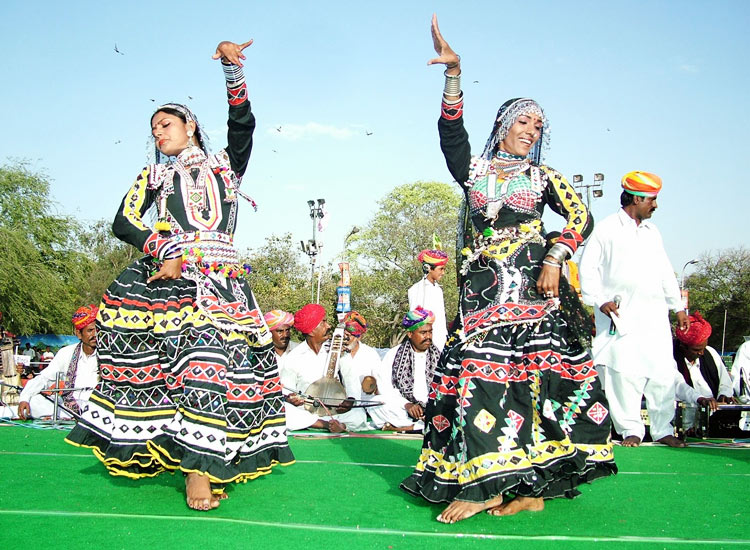
UNESCO inscribe Kalbelia, a form of folk songs and dance in Rajasthan as an Intangible Cultural Heritage in 2010. This incredible dance and music performance comes from actually an untouchable community from Rajasthan who led nomadic lives. Traditional known as snake charmers, the community relied on trading of snakes and snake poison. Later the women took control of their livelihood and entertained people with their dance while the men provided the music by poongi (a snake charming instrument).
Kalbelia is a sensuous form of dancing, which mimics the movements of snakes in some sense. Dressed in black with colors, mirrors and other ornaments, the women allure with their fluid dance moves while the musical instrument ‘poongi’ and songs are sung by men. Kalbelias also compose their own songs and improvise it according to the changing times. The songs are passed on from generations orally, the heritage of the community is the people itself.
9.Ramman – Religious festival and ritual theatre of the Garhwal Himalayas

Ramman is a religious festival celebrated only in the Garhwal region of Uttarakhand, specifically among the Hindu community in the Saloor-Dungra village. The unique tradition is practiced and continued by a small community of 1800 people and 196 families without difference on caste and creed. UNESCO inscribed Ramman on the list of Intangible Cultural Heritage in India on 2009.
Held annually in April (Hindu month of Baishak), the festival worships the local deities of the village and also celebrates the time before hard work and harvest season. In the temple complex as a part of the festivities, a ritual theatre is organized where 18 people play 18 characters, wearing 18 masks to dance on 18 beats to celebrate the 18 puranas. Inspired from Ramayana, Ramman narrates stories of Ramayana, Hindu texts as well as local stories are narrated. Bringing together the community, festivities are a way to keep alive the history and heritage of the village community.
10.Ramlila – The Traditional Performance of the Ramayana
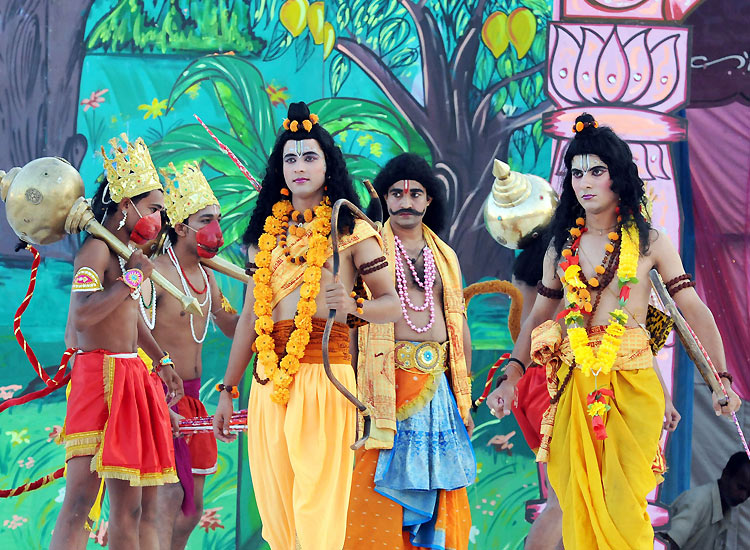
Ramayana is one of the holiest Hindu scriptures in India. The epic devoted to the glory of Rama was translated to Awadhi language from the original texts available in Sanskrit by Goswami Tulsidas in the 16th century. Ramlila is the traditional performance of the Ramayana, basically the life of Lord Rama till his victory over the Demon King Ravana. UNESCO inscribed Ramlila on the list of Intangible Cultural Heritage on 2008.
During the Sharad Navratras (October – November), Ramlila is performed. The performances can be anything from 10 days to 40 days. Actors narrate the story of Lord Rama, his life, struggles in a number of episodes with teachings of life, philosophy and concepts of evil & good. The performance is a part of the Indian cultural heritage where the stories of the Hindu Epic were performed by actors in front of the masses so that everyone could learn from the knowledge of Ramayana.
11.The Tradition of Vedic Chanting
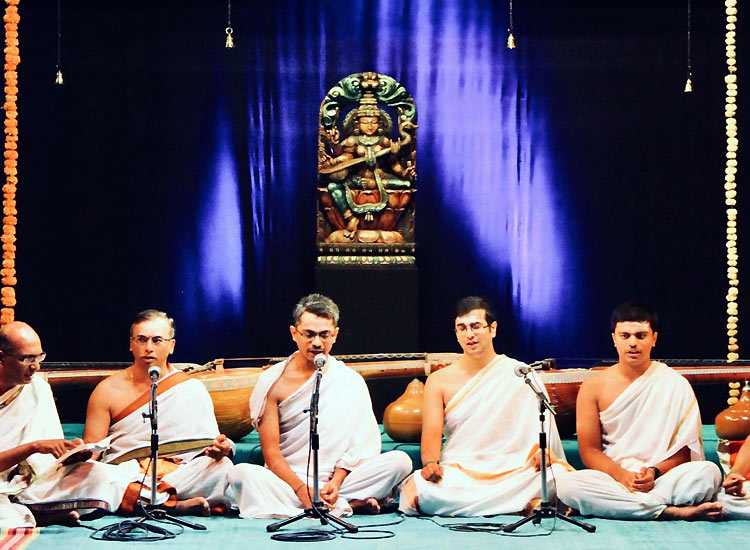
The traditional way of reciting the Vedas- Vedic chanting is inscribed by UNESCO on the list on Intangible cultural Heritage in 2008. Vedas are the primary source of knowledge on Hindu philosophy, science, myths, art, rituals and traditions that go back to about 3,500 years to the time of the Aryans. There are four chief Vedas – Rig, Yajur, Sama and Atharva. The Vedas though originally written in Vedic Sanskrit, have since been translated to Classical Sanskrit. Brahmins (priests) passed down the knowledge of Vedas in form of oral rendition down the generations.
Vedic chanting is taught right from childhood to ensure that the sound of each word remains unaltered and they follow a unique manner of pronunciation. Although Vedas are still an important part of Hinduism, only 13 Vedic recitation branches have survived from over 1,000 branches. These recitation schools are now only found in Maharashtra (central India), Kerala and Karnataka (southern India) and Orissa (eastern India).
12.Mudiyett, ritual theatre, Kerala
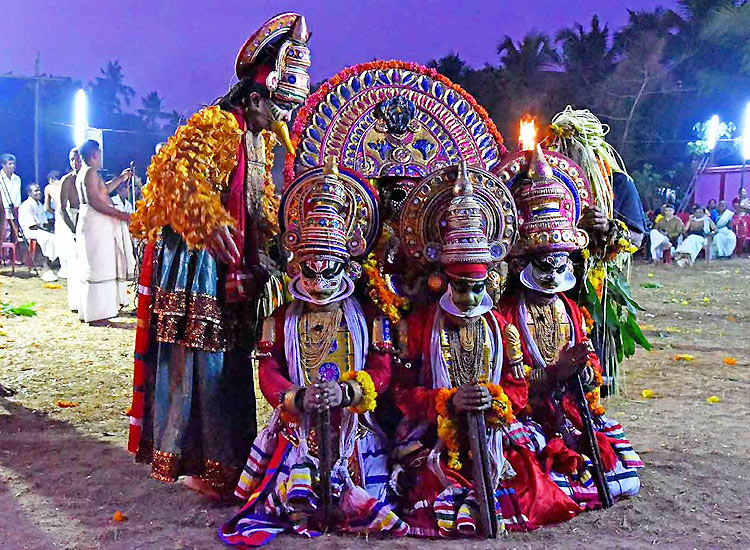
A ritual theatre of Kerala, Mudiyett re-enacts the tale of Goddess Kali and Demon Darika, Performed for purification, the 4-day festival is a part of the Bhagwati cult. In fact, it is performed only by members of the Marar and Kuruppu communities in Thrissur, Ernakulam, Kottayam and Idukkidistricts of Kerala. After the summer harvest, the entire community participates in the reenactment of mythological tale of the Goddess and the Demon. The unique ritual theatre of Kerala is a communal activity, inscribed on the list of UNESCO Intangible Cultural Heritage.
A complete Mudiyettu performance requires a total of 16 people from the entire community without difference in caste or creed. The figure of Kali is painted on the floor of the temple and then a specific song is sung describing the goddess from head to toe, invoking the Goddes before the ritual. Musicians known as masters of Sopana Sangeeth, a branch of Carnatic music accompanies the ritual.
13.Kutiyattam, Sanskrit Theatre, Kerala
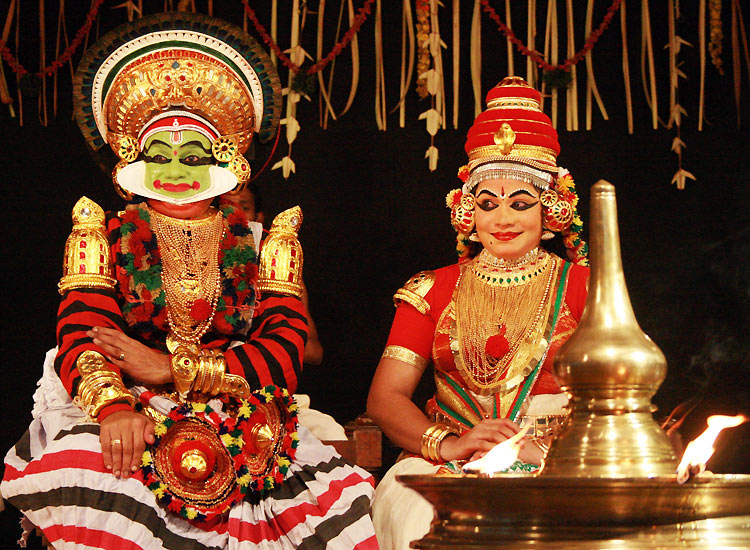
Native to Kerala, the Kutiyattam is India’s oldest existing classical theatre. Inscribed by UNESCO as Intangible Cultural Heritage of India in 2008, it among the dying art forms in India in need of preservation. It started traditionally a temple festival, performed only by Chakyars and Nangiars, women of Nambiar caste.
The theater form uses elements of Sanskrit Theatre and Koothu, besides elements of theater as old as the Sangam era. The dance performance is always accompanied by many musical instruments. The Kuzhithalam among the musical instruments is played only by a member of the Nambiar caste. Each of the performers or actors of the art have to go through arduous training. of breathing control, subtle muscle shifts and expression for ten to fifteen years before they to actually perform in the temple festivals.
Focused on detail and elaboration, even a single act lasts for days. The colorful attires, massive headdresses, music, verses, and setting altogether recreate a story from mythology, vedas or other religious texts
